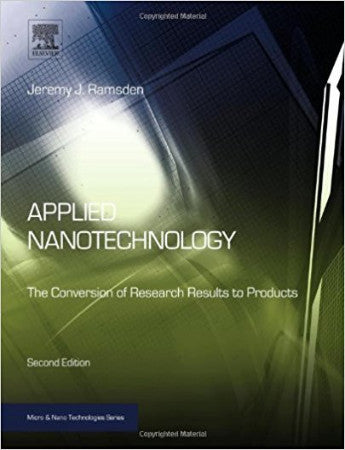The editor has drawn together contributions from academics, materials suppliers, product manufacturers, NASA and the US army, which show how these materials really perform, and where they are already finding uses. Flame retardancy and barrier properties are key benefits.
Performance, however, is only part of the story. To achieve commercial success new materials must also deliver these properties safely and predictably. Processing is a key issue when investment in new equipment may not be an option. There are questions regarding the health impacts of all nanoscale particles. All these topics and more are covered in the following sections:
• Developments in Commercial Polymer Nanocomposite Materials
• Working with Polymer Nanocomposite Materials
• Unique Properties of Polymer Nanocomposites
• Polymer Nanocomposites in Demanding Industrial Applications
Developments in Commercial Polymer Nanocomposite Materials
1. Synthesis, structure, properties, and characterization of organically modified clay minerals by Hendrik Heinz, University of Akron, USA
1.1 Overview of clay minerals1.2 Synthesis of organically modified clay minerals
1.3 Structure of organically modified clay minerals
1.3.1 Effect of cation density on the surface and the inorganic interface
1.3.2 Low packing density
1.3.3 Medium packing density
1.3.4 High packing density
1.3.5 Non-quantitative ion exchange
1.4 Characterization and properties of organically modified clay minerals
1.4.1 X-ray diffraction, microscopy, and structural properties
1.4.2 DSC, DTG, thermal transitions, and thermal decomposition
1.4.3 IR/Raman spectroscopy, NMR spectroscopy, and chain conformation
1.4.4 Dielectric, elastic, and tilt angle measurements
1.4.5 Surface tension measurements and cleavage energies
2. Polymer nanocomposites formulated with hectorite nanoclays by Günter Beyer, Kabelwerk Eupen AG, Eupen, Belgium
2.1 Introduction2.2 Thermal stability of hectorite-based nanoclays and nanocomposites
2.2.1 Nanoclay stability
2.2.2. Effect of the nanoclay on the degradation process of the matrix polymer
2.2.3 Thermal stability of the produced nanocomposites
2.3 Flame Retardant properties of hectorite-based nanocomposites
2.4 Barrier properties of hectorite-based nanocomposites
2.5 Nanocomposite foams formulated with hectorite nanoclay
2.6 Nanoclay dispersion in thermoplastics
3. Polymer nanocomposites based on carbon nanotubes by Olivier Decroly, Nanocyl SA, Sambreville, Belgium
3.1 Introduction3.2 Carbon nanotube nanocomposites
3.2.1 Conductive Carbon nanotube nanocomposites
3.2.2 Structural composite applications
3.2.3 Coatings applications
Working with Polymer Nanocomposite Materials
4. Processing of polymer nanocomposites by Daniel Schmidt, Dept of Plastics Engineering, University of Massachusetts, USA
4.1 What is processing and why is it necessary?4.2 What is needed to process a polymer nanocomposite?
4.2.1 Enhancing polymer mobility
4.2.2 The consequences of processing
4.2.3 A balanced approach
4.3 Does the polymer have to be a solid at room temperature?
4.4 Do we need to start with a polymer at all?
4.5 Can we do away with the pre-formed nanofiller as well?
4.6 What are our options as far as pre-formed nanofillers?
4.7 What makes a nanofiller disperse in a particular polymer during processing?
4.7.1 The thermodynamics of dispersion: entropy
4.7.2 The thermodynamics of dispersion: enthalpy
4.7.3 Complications: crystallinity
4.7.4 Complications: multi-phase systems
4.7.5 Achieving thermodynamic compatibility – practical considerations
4.7.6 The kinetics of physical dispersion
4.7.7 Dispersion kinetics in the presence of chemical reactions
4.8 What should a “well-processed” polymer nanocomposite look like
4.8.1 The realities of nanocomposite processing
4.9 What are our options for nanocomposite processing?
4.9.1 The importance of pre-processing
4.10 What processing techniques involve just polymer and nanofiller?
4.10.1 Physical mixing/dry blending
4.10.2 Compaction
4.10.3 Solid state shear processing
4.10.4 Melt blending
4.11 What additional options do we have with solutions
4.11.1 Physical mixing/“wet blending”
4.12 What about reactive processing?
4.13 Are there any additional considerations?
5. Stabilisation of polymer nanocomposites by Rudolf Pfändner, Ciba Lampertheim GmbH, Lampertheim, Germany
5.1 Introduction5.2 Challenges of stabilisation of filled polymers
5.3 Processing and long-term thermal stabilisation of polymer nanocomposites
5.4 Light stabilisation of polymer nanocomposites
5.5 Summary and outlook
List of stabilisers
6. Toxicology of nanoparticles relevant to polymer by Paul Borm, Centre of Expertise Life Sciences (CEL), Hogeschool Zuyd, Heerlen, Netherlands
6.1 Introduction6.2 Toxicological effects of nanoparticles
6.2.1 Particle definitions
6.2.2 Effects of nanoparticles upon inhalation
6.3 Nanoparticles used in nanocomposites
6.3.1 Carbon nanotubes
6.3.2 Metal oxide particles
6.3.3 Silica and organoclays
6.4 Need for unifying concepts
Unique Properties of Polymer Nanocomposites
7. Flame retardancy from polymer nanocomposites – from research to technical products by Günter Beyer, Kabelwerk Eupen AG, Eupen, Belgium
7.1 Introduction
7.2 Organoclay nanocomposites
7.2.1 Processing and structure of EVA/organoclay-based nanocomposites
7.2.2 Thermal stability of EVA/organoclay-based nanocomposites
7.2.3 Flammability properties of EVA/organoclay-based nanocomposites
7.2.4 NMR investigation and FR mechanism of nanocomposites
7.2.5 Intercalation versus exfoliation in EVA/organoclay-based nanocomposites
7.2.6 Combination of the classical flame retardant filler ATH with organoclays
7.3 Cable Applications
7.3.1 Coaxial cable passing UL 1666 fi retest with an organoclay/ATH-based outer sheath
7.3.2 Medium voltage cables with organoclay/ATH-based outer sheaths
7.3.4 Energy cables passing prEN 50399 with an organoclay ATH-based outer sheath
7.4 Synergistic effects with halogenated flame retardants
7.5 Commercial examples of nanocomposite-based compounds
7.6 Carbon nanotube composites
7.6.1 General properties of carbon nanotubes
7.6.2 Synthesis and purification of CNTs
7.6.3 Flammability of EVA/MWCNT compounds and EVA/MWCNT/organoclay compounds
7.6.4 Crack density and surface results of charred MWCNT compounds
7.6.5 Flammability of LDPE/CNT compounds
7.6.6 Cable with the new fire retardant system MWCNT/organoclay/ATH
7.7 Outlook
7.8 Summary
8. Polyhedral oligomeric silsesquioxane flame retardancy by Joseph Lichtenhan, Hybrid Plastics Inc., Hattiesburg, USA
8.1 Introduction
8.2 POSS chemical technology and unique features
8.3 Successful use of POSS as a fire retardant
8.4 Conventional fire retardants and POSS
8.5 POSS and fire-retardant coatings for textiles
8.6 Commercial applications
8.7 Conclusions
9. Barrier property enhancement by polymer nanocomposites by Tie Lan and Ying Liang, Nanocor Inc., Hoffman Estates, USA
9.1 Introduction9.1.1 Organoclay materials
9.2 Formation of polymer-clay nanocomposites
9.3 Nano-effects in barrier enhancement
9.4 Summary
10. Status of biodegradable polymer nanocomposites for industrial applications by Jo Ann Ratto, Christopher Thellen and Jean Lucciarini, US Army Natick Soldier Research, Development, and Engineering Centre, USA10.1 Introduction
10.2 Biodegradable polymers
10.3 Nanocomposites
10.3.1 Structure of montmorillonite layered silicates (MLS)
10.3.2 Morphology of polymer/MLS nanocomposites
10.4 Biodegradable nanocomposites
10.5 Biodegradability
10.5.1 A recent study of PHB nanocomposites
10.6 Processability issues
10.6.1 A recent study of PCL nanocomposites
10.7 Attainable properties
10.7.1 A recent study of PLA/PCL nanocomposites
10.8 Performance data
10.9 Commercially viable materials
10.9.1 A recent study comparing biodegradable nanocomposites to polyethylene terephthalate (PET)
10.10 Applications
10.10.1 A recent patent on biodegradable polymeric nanocomposite compositions
10.11 The future of biodegradable nanocomposites
10.11.1 Life cycle assessment for biodegradable nanocomposites
10.11.2 Safety of biodegradable nanocomposites
10.12 Summary
11 Thermal properties of polymers with graphitic nanofibres by Ernst Hammel, Andreas Eder and Xinhe Tang, Electorvac AB, Klosterneuburg, Austria
11.1 Introduction
11.2 Thermal Interface Materials
11.3 Thermally Conductive Plastics
11.4 Conclusions
Polymer Nanocomposites in Demanding Industrial Applications
12. Automotive industry applications of polymer nanocomposites by William Rodgers, General Motors Corp. Research and Development Center, Warren, USA
12.1 Introduction12.2 Requirements for the automotive industry
12.2.1 Surface appearance
12.2.2 Measurement techniques
12.2.3 Aspect Ratio
12.2.4 Minimization of mass
12.3 Manufacture of nanocomposite systems
12.3.1 In-situ polymerization
12.3.2 Melt processing
12.3.3 Injection moulding
12.4 Applications of nanocomposites in the automotive industry
12.4.1 Applications using carbon nanotubes
12.4.2 Applications of organoclay nanocomposites
12.4.2.1 Underhood applications
12.4.2.2 Exterior applications
12.4.2.3 Interior applications
12.5 The future of nanoclay composites
12.5.1 Alternative conventional filler materials
12.5.2 Exfoliation issues with olefinic resins
12.5.3 New nanomaterials
12.6 Concluding remarks
13. Polymer nanocomposites in aerospace applications by Michael Meador, NASA Glenn Research Centre, Cleveland, USA
3.1 Background
12.3.2 Melt processing
12.3.3 Injection moulding
12.4 Applications of nanocomposites in the automotive industry
12.4.1 Applications using carbon nanotubes
12.4.2 Applications of organoclay nanocomposites
12.4.2.1 Underhood applications
12.4.2.2 Exterior applications
12.4.2.3 Interior applications
12.5 The future of nanoclay composites
12.5.1 Alternative conventional filler materials
12.5.2 Exfoliation issues with olefinic resins
12.5.3 New nanomaterials
12.6 Concluding remarks
13. Polymer nanocomposites in aerospace applications by Michael Meador, NASA Glenn Research Centre, Cleveland, USA
13.1 Background13.2 Clays
13.2.1 Background
13.2.2 Cryotanks
13.2.2.1 Permeability
13.2.2.2 Toughness
13.2.3 Other structures
13.3 Carbon-based nanostructured additives
13.3.1 Carbon nanotubes
13.3.1.1 Synthesis methods
13.3.1.2 Purification
13.3.1.3 Functionalization
13.3.2 Carbon nanotube-based nanocomposites
13.3.2.1 Electrical and thermal conductivity
13.3.2.2 Mechanical properties
13.3.3 Carbon nanotube-based fibres
13.3.4 Other nanoscale carbon additives
13.3.4.1 Expanded graphite and nanocomposites
13.3.4.2 Graphite oxides and nanocomposites
13.3.4.3 Functionalized graphene sheets and nanocomposites
13.4 Conclusions
Glossary of materials and techniques referred to in this chapter
References
Appendix
Glossary of abbreviations
Index




